“We’re encouraged by what we’re hearing in our conversations with ODOT and we really feel like we’re going to be able to accomplish a lot.”
– Dylan Rivera, PBOT
16 days after the death of Sarah Pliner outside Cleveland High School, the City of Portland and the State of Oregon have implemented the first pieces of a plan they hope will ensure it never happens again.
This morning just after 9:00 am, Portland Bureau of Transportation crews added new “20 MPH Speed Limit” and associated school zone signs to SE 26th in front of the high school. This comes about 24 hours after a resolution passed with unanimous support at Portland City Council gave them the authority to do so. When I visited the school this morning, I also noticed that new zebra-striping (a.k.a. “continental crosswalk”) has been added to all four of the existing crosswalks at the 26th and Powell Blvd intersection.
At the southeast corner where Pliner was hit by a truck driver, additional paint striping has been added to create a visual space buffer for turning drivers. Plastic turn-calming bumps (already in use citywide) are also in the plans and should be installed on this corner soon.
And these are just the start of changes in store.
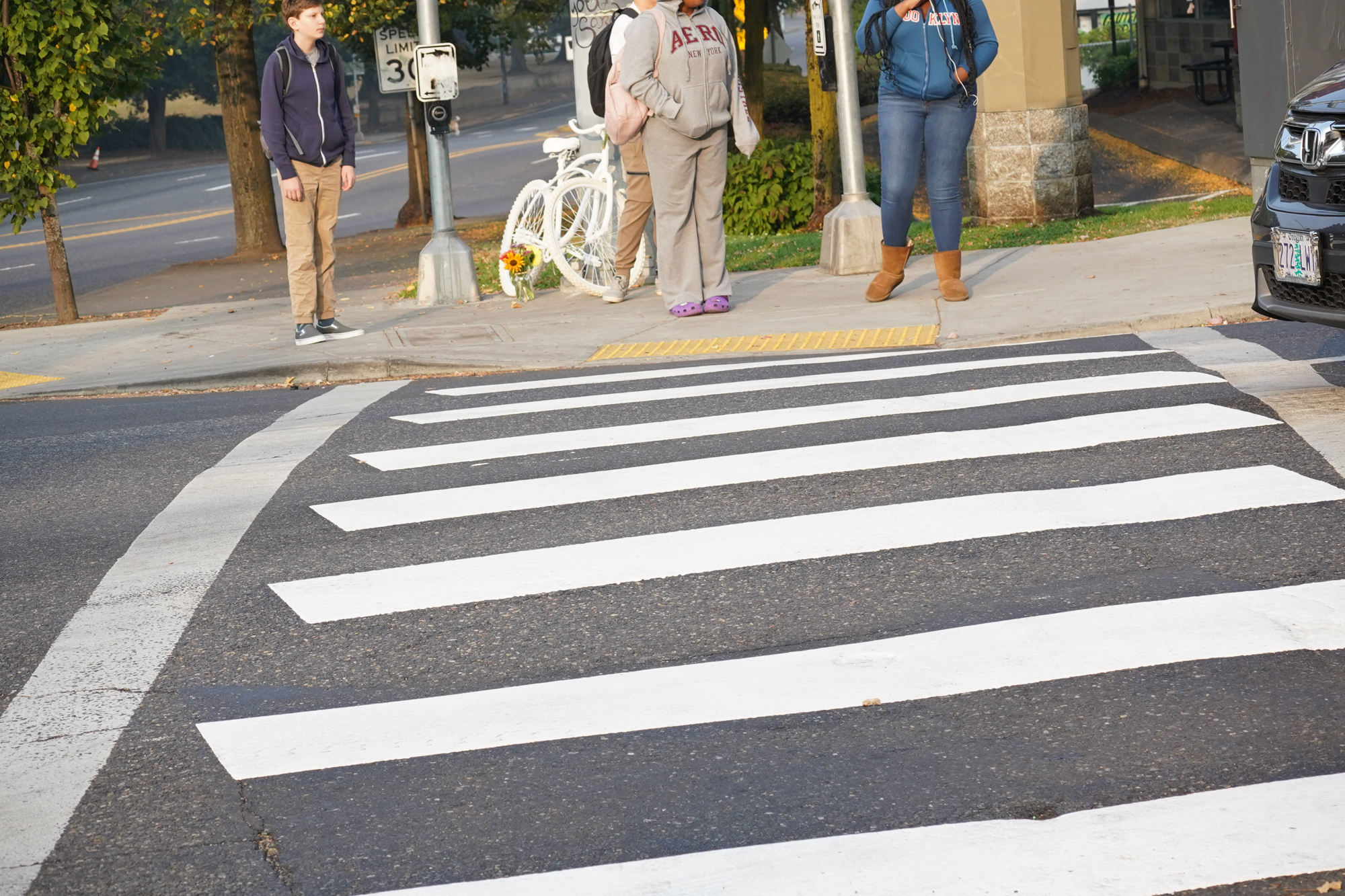



PBOT Public Information Officer Dylan Rivera was at this morning’s sign installation event (PBOT invited the media an hour before it happened). From his comments it sounds like there has been very close and positive communications between PBOT and the Oregon Department of Transportation. This is notable not just because the two agencies often clash over infrastructure designs and priorities, but because they had a very ugly battle at this specific location four years ago that could have played a role in the death of Sarah Pliner.
In 2018, ODOT forged a compromise with PBOT over existing bike lanes and bike boxes on SE 26th at Powell Blvd. ODOT was nervous about bike/truck safety issues given the long history of collisions, and PBOT wanted to build a new signalized crossing for a neighborhood greenway just a block south on SE 28th. (Since 28th crosses Powell — a state highway — ODOT has total veto power over any PBOT plans.) Seeking ODOT permission to build the 28th Ave crossing, PBOT agreed to remove the bike lanes on 26th in a bid to persuade riders to avoid it and use 28th instead (PBOT was under pressure to demonstrate high volumes of bike/walk users at 28th because ODOT requires minimum traffic counts to comply with FHWA “warrants” needed to permit a new signal). But since many people still biked on 26th, the risks remained while the infrastructure was made even more dangerous. ODOT promised to install wayfinding signs on 26th to direct bike traffic to 28th — a request made by The Street Trust — but those were never installed.
Then Sarah Pliner was hit and killed.
Then ODOT Director Kris Strickler made a public statement about the intersection that was unprecedented in its tone and timing. He said no change would be off the table, that he wanted to “quickly transform” Powell Blvd, and that it, “should not, function as a traditional highway anymore.”
Those are jaw-dropping things for the most powerful person at ODOT to say. But did he really mean it? So far it seems like he did.
Today, PBOT’s Rivera said ODOT has been a willing partner. The first sign was the new striping in the crosswalks on Powell, which Rivera said PBOT pushed for and ODOT obliged.
In addition to that striping and the new school zone signs and speed limit reduction outside Cleveland High, PBOT also plans to: move two bus stops on 26th north of Powell to pull them further away from the intersection; stripe a new mid-block crossing with a concrete median island mid-block in front of the schools main entrance on 26th; reconsider freight route classifications to remove as much truck traffic from 26th as possible; and re-install the green bike lanes and bike boxes that were removed in late 2018.
That last item got my attention. I can’t recall PBOT ever re-installing a bikeway that ODOT forced them to remove. It would be quite a coup if that were to happen. And it would demonstrate an amazing level of self-reflection and maturity from ODOT. I asked Rivera what’s different today than back in 2018. “We’re hearing a different message from ODOT today,” he replied, carefully.
Rivera also let slip that there could be a median island as part of a new crossing treatment on Powell in the future. That would be another huge move from ODOT since they are typically very reluctant to reduce driving capacity on state highways. (On that note, it’s telling that no one has brought up the one thing that could lead to a substantive change in the safety of traffic on Powell Blvd: A road diet.)
A missing crosswalk safety tool
Rivera also said PBOT “would like to see” the installation of leading pedestrian intervals (LPIs) on the 26th Avenue crossings. These are proven safety tools where the signal turns green for crosswalk users before other lane users so they get a head-start into the intersection (not to be confused with a “scramble signal” where all traffic is required to stop for people crossing the street).
It’s important to note that back in April 2018, ODOT Region 1 Manager Rian Windsheimer promised to install LPIs here. In a letter (PDF) to The Street Trust (cc’d to PBOT director and commissioner staff), Windsheimer wrote, “ODOT will be implementing LPIs on the crossings of Powell Blvd at SE 26th Ave. This will allow pedestrians to get into the crosswalk where they are more centered in a driver’s field of vision, before the driver can begin making a right turn.”
But a leading pedestrian interval was never installed.
This morning I asked ODOT Region Public Information Officer Don Hamilton why. “It’s on our list of things to do at 26th,” he replied. “Coming soon.”
ODOT owns the signals on Powell, but they have an agreement with PBOT for the city to maintain and operate them. PBOT’s Rivera said the LPIs haven’t been installed yet because the software that runs them needs an update. “We need to swap out a controller part,” he shared in a phone call a few minutes ago. “We believe we have the funding and the ability to do that in the next several months at 26th and 21st.”
It sounds to me like PBOT planners and engineers have swung quickly into action with a suite of changes they want to see on and around SE 26th and Powell — and that ODOT is giving them a much warmer reception than usual. This shouldn’t be a big deal, given that this is an urban area in the city of Portland where a lot of people have been injured and killed over the years. But unfortunately the bar of expectations for ODOT in these situations in the past has been set extremely low.
What does Rivera make of all this?
When I asked him if PBOT was going out on a limb and pushing their plans over ODOT objections, he said that wasn’t the case at all. “ODOT has decided to accept the things that PBOT has been proposing, designing, and advocating for,” he said. “This is not, kind of a ‘going rogue’ and see how they [ODOT] respond kind of thing,” he continued. “We’re encouraged by what we’re hearing in our conversations with ODOT and we really feel like we’re going to be able to accomplish a lot.”
Learn more about what’s in store at tonight’s SE Powell Blvd Community Safety Forum.



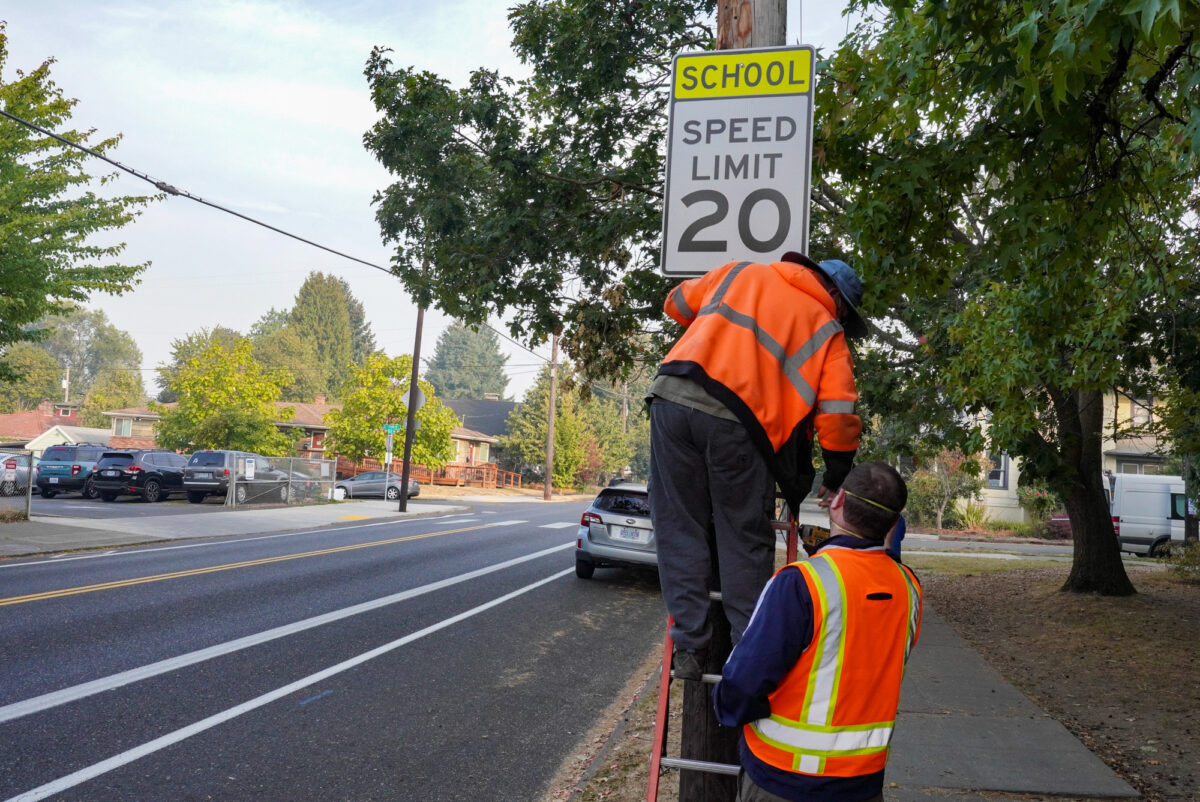
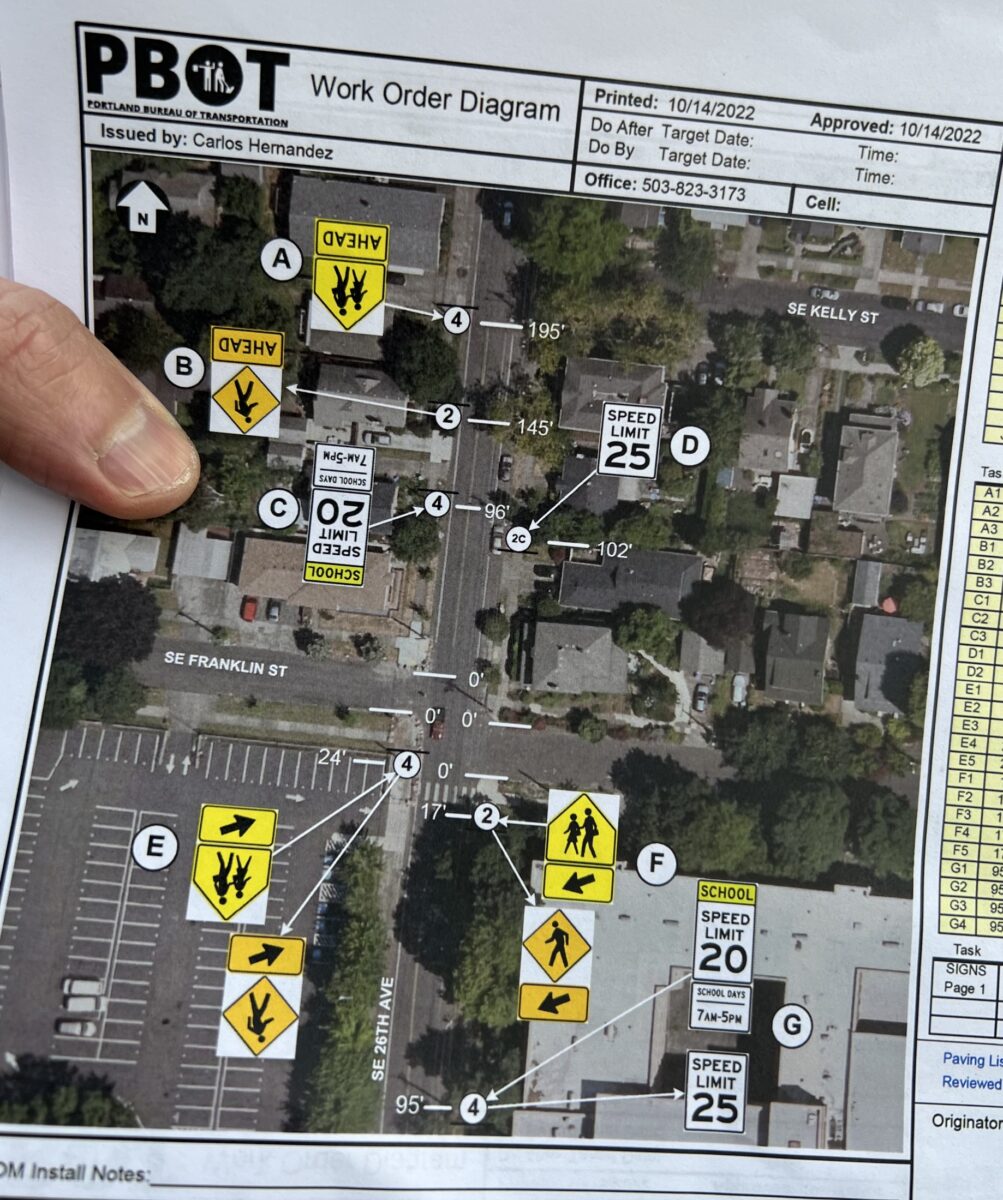
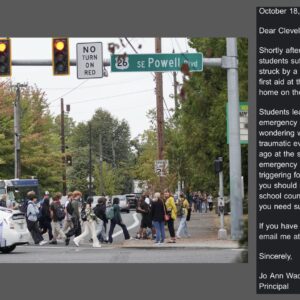


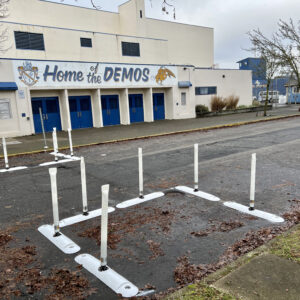
Thanks for reading.
BikePortland has served this community with independent community journalism since 2005. We rely on subscriptions from readers like you to survive. Your financial support is vital in keeping this valuable resource alive and well.
Please subscribe today to strengthen and expand our work.
Has Hardesty kept that program Eudaly started of putting out road signs at places where people are hit warning drivers it’s a dangerous road? If so was one put up for Sarah? I felt like that was an effective way at helping keep drivers cautious and aware and not just returning to zombie mode as quickly.
Good question! I’ve seen other folks ask about that. I know it has happened since Hardesty’s been in office. Last one I heard about was Martin Crommie earlier this year. I wonder if PBOT felt like there just wasn’t anywhere to put it this time? I’ll try to find out.
That or maybe ODOT wouldn’t allow it. I remember when Martin Weiner died on Market and the 205 path they put the sign on 92nd just north of Market. Even though there was plenty of room on Market and I figured that was the reason.
The “High Crash Intersection” signs are all over east Portland. This intersection is not in the top 30 high crash intersections the COP accounts for.
Let’s just say that this would be a good location for a sign.
When someone was killed on Fremont I noticed that no sign had been put out. I contacted Hardesty’s office and PBOT and received a quick response that the sign was coming but had not been placed yet. It appeared 1-2 days later. I believe they are still doing it but there is often a delay before it is actually set up.
I’ve seen them around town within the past year.
No signage can keep drivers cautious. Sad, but true.
These should also come with multiple rows of temporary speed bumps so that more drivers notice the signs and consider how they are operating deadly machinery.
Temporary? How about permanent asphalt speed bumps? Every time a vulnerable road user is killed, add a bump.
One of the many things I love about Mexico is the frequent use of a series of suspension-crunching topes to prevent speeding near areas where people have been seriously injured, maimed, or killed. The fact that these are often installed without permission of tranportation authorities makes them even cooler.
I noticed these things when I was driving in Cabo last year, they are no joke, they slowed me down a lot more than the humps around Portland. They aren’t just installed on neighborhood streets either, the highway from the airport to the resort areas had many of them.
One of the reason these are not more popular is the issue that nearly every time snow is removed (from a high priority corridor) the speed bumps are damaged and eventually become a hazard.
I’ve heard of cities in snowier climates installing rubber speed bumps that can be removed for the winter and reinstalled in warmer months. I can’t imagine pbot or odot actually having the wherewithall to do something like that, given they can’t even sweep bike lanes with the fancy bike lane sweeper they have sitting idle in their maintenance yard. But some more functional transportation agencies can pull that kind of thing off.
Some of the most suspension-damaging topes in Mexico are recessed bumps that appear compatible with snow removal (which is rare in PDX and likely increasingly rare in coming years).
Art Pearce is your go-to at PBOT for this.
Here is the report on fatality readerboards from my neighborhood for the last year:
1.A readerboard for Austin Boyd, age 23, graduate of Cleveland High School, pedestrian killed by a hit-and-run driver on 9-11-21 at SE Clinton and César Chávez was set up at SE Lincoln and Chávez, 7 blocks away from the crash.
2.The readerboard for Ryan Dickenson, age 34, member of nearby encampment, pedestrian killed on 10-1-2021 at SE 29th and Powell, was set up at SE 22nd and Powell, also 7 blocks away.
3.When pedestrian Tralee McClain, age 31, graduate of Cleveland High School, was killed on 10-30-21, also at SE 29th and Powell, a new readerboard was not set up.
4.I have not yet seen one for Sarah Pliner, age 50, beloved local chef, bicyclist killed at SE 26th and Powell on 10-4-22.
Art explained to me the reasons why the reader boards could not be set up at or closer to the crash sites. But 7 blocks is nearly a half a mile away. Could we brainstorm another way? How about a white corrugated-plastic life-size silhouette cut-out like Oregon Walks put up all around the city for the World Day of Remembrance in 2015 for each of the 135 Portlanders killed on the roads between 2004 and 2014?
https://www.bloomberg.com/news/articles/2015-11-20/in-portland-plastic-silhouettes-pay-tribute-to-traffic-victims
This would be something that could stay for a long time, the way a white bicycle does.
A readerboard is at Southeast 22nd and Powell Boulevard now. It does not look like it is turned on at this time. It has graffiti on it.
There has been a ghost bike on the NW corner of SE 26th and Powell since about 3 days after Sarah died there.
PBOT should not “reinstall” the bikeway on 26th — the lanes have always been dangerously substandard. They should either:
1. Remove on-street parking to allow a safe set of bike lanes; or
2. Add parking to the west side and make the travel lanes truly shared, with sufficient traffic calming to get drivers to slow down.
In either case, PBOT should also extend the greenway on SE 21st from Clinton to Gladstone (via some combination of 21st & 22nd), which is what I think it would take to get folks to stop riding on 26th. 28th, while close, feels far and out-of-direction (even though it’s not). It’s a weird psychological trick, probably a result of the hills and the ultra-long crossing wait times during peak hours.
I’d rather take the lane (and thus be in full view of truck drivers) on a road like 26th than ride in such a dangerous bike lane (and be obscured from the vision of the drivers). I would see adding back the lanes and bike box, with no other changes simultaneously implemented, to be a step backwards in terms of safety.
(I’m in agreement with your points above).
Bike boxes allow people on bikes to move out ahead of traffic into a more visible position. Combined with LPI or bike specific signal phases, they greatly enhance the safety of people on bikes.
Since I’m thinking about SE 21st, I’ll add it needs some bike boxes at Powell. A lot of folks cross there, and while it’s a lot better than it used to be, it’s still a bit dicey. A bike box would definitely help.
Definitely!
There seem to be many current riders who lack this knowledge. If you are in the street on a bicycle, you are a vehicle. The law says you ride as far to the right as practical.
At an intersection, “practical” is the middle of the lane. There drivers behind are unlikely to start to pass and then turn into you. Cross traffic is more apt to see you in the middle of the lane than when you are near the curb. Of course, this presupposes you are also wearing high visibility clothing and/or lights.
Note that “practical” also includes moving into the lane because the curbside is filled with glass, gravel, leaves, and/or trash. Bicycles have road rights, just like automobiles. Motor vehicle drivers need to accommodate their fellow vehicles, and cyclists need to ride alertly, with good sense, but also with awareness of where true safety lies, which is not always along the curb.
We tried vehicular cycling infrastructure since the 1990s, it doesn’t work, stop trying to make it a thing. If it works for you great. But most people don’t feel comfortable doing that so the infrastructure should accommodate them.
Alexander, I appreciate Ruth’s advice. Portland’s Bike network is highly incomplete and filled with gaps. At best, you will need to take greenways, nearly all of which lack diversion. This means that, like it or not, a person riding a bike will need to use the ideas of vehicular cycling to stay safe. Vehicular Cycling IS THE SYSTEM we have. We have partial routes and segemnets, but if you are going to use a bike as transportation, you will need to use the tips Ruth has provided.
I sympathize with your point of view. I completely agree that separated bicycle routes are a far better way to go. I will note that unless the bike way is completely separate, including separate intersections, one will still have problems with motor vehicles at shared intersections. I in no way wish to be stuck at the right, separated or not, at an intersection where I face motorized cross traffic and vehicles turning across my lane.
The current infrastructure of separated bike paths is inadequate for regular transportation. Practically, I find it next to nonexistent. Travel to most locations requires a significant portion of the trip on shared roadway.
My point was, and I can see I was not specific on this, that if one is riding on a street with motor vehicles, one cannot safely ride right along the curb at all times. As a cyclist, one has the same right to the road as a motor vehicle. In the city, maintenance of curbside roadway, ranging from pavement and drain maintenance to clearing of debris, is very poor. I’m unwilling to ride on broken pavement, loose gravel, broken glass, wet leaves, and take-out trash. And I absolutely refuse to sit at the curb while waiting for a light change.
I like your term “vehicular cycling”. I’d not heard it before. I’ve cycled for transportation since the 1960’s, and have been aware of and mindfully cycling as a vehicular cyclist since the `70’s. When I must share the roadway with motor vehicles, I take the share of the roadway needed for safety. Of course I am also helmeted and dressed for visibility. I also signal all turns and lane changes, e.g. from curbside into lane center, and I can look over either shoulder to check traffic behind me without swerving out of my line of travel. It took time and effort to develop adequate skills as a vehicular cyclist, and even then, I know I am still far more vulnerable than even a motorcyclist is.
In regard to separated bike ways, I might as well also note that as a pedestrian I favor bike ways separated from pedestrian traffic as well. Cyclists traveling combined pedestrian/bike paths need to travel at speed compatible with pedestrians. That is not at vehicular speed, but rather something around the speed of jogging. When cycling, I find such slow speed frustrating. I seldom use combined paths for biking unless on a strictly recreational ride.
They already removed parking on one side of SE 26th to accommodate the existing bike lane. I agree the bike lane is substandard but it’s too good of a route for cyclists not to use it. Meaning that it is the rare north south route that connects useful destinations and has flat topography and relatively good pavement.
Could someone please patiently explain how these changes will prevent a huge semi heading north on 26th from making a right turn onto Powell to head east? Or failing that, prevent pedestrians and bicyclists from accidentally getting in the way of that turning semi’s rear wheels?
It’s been 16 days. And the big event where we are likely to learn more is set for tonight. I’m almost certain ODOT will add something substantive like a temporary truck ban on 26th or something like that. Also, the LPI would be a great step toward preventing right-turn collisions.
What about the curb at the corner? Seems to me that one of the biggest dangers and worst design elements at that corner is the wide radius corner with mountable concrete. Maybe painting stripes on it will help to encourage people to make wider turns (until the paint fades and the thermo plastic gets ground away by studded tires in three or four months), but I think it would be better, safer, and more durable to revert to the pre 2019 curb layout. Yes, it would make the turn much more difficult to navigate for giant semi trucks, but isn’t that the point? This should be converted into the least inviting intersection for freight that it possibly can be. Plastic bumps are really just a band aid, and they will inevitably get destroyed in short order. If you’re serious about safety, you’d pour some concrete curbs.
A truck driver making a wide turn is exactly what got someone killed here two weeks ago. Forcing wider turns with your proposal here, in my view, would result in a dramatic decrease in safety.
Nacto design guidelines strongly advise against wide radius corners to facilitate freight right turn movements (https://nacto.org/publication/urban-street-design-guide/intersection-design-elements/corner-radii/ ). The redesign of that corner that occurred several years ago went against best safety practices for road design.
STRONGLY disagree. Turns may be wider, but they will be SLOWER. This is incredibly important because it gives people time to react. ODOT should be airming for turns with a full sized truck to be moving at the speed of a literal crawl.
A sharp corner plus a concrete Jersey barrier on the median and virtually no semi driver would ever dream of turning there.
LPIs should apply to people who roll and walk. Even better would be a scramble phase where all people walking and rolling can proceed.
It’s dissapointing but not suprising that this was not one of the asks of all of those non-profits.
Everyone involved in the 26th bike lane story (ODOT, PBOT, The Street Trust) should feel deep shame at the outcome.
If I’m in a bike box and the LPI signal changes, I’m going. Not sure about what y’all do at those intersections.
Most of the LPIs I’ve seen and used last for only a few seconds, but in DC most are 30 seconds and some near the national mall are even as long as 90 seconds. Most motorists in DC expect bicyclists to use the LPIs as pedestrians, that is bike forward or turn or whatever when the ped signal turns green or white.
Portland’s seem to last for 6-8 seconds because PBOT is always terrified of inconveniencing drivers.
ODOT is studying a road diet for Powell.
“studying”
Something to note in all of this, the streets between Brooklyn Yard and 26th (inclusive) are all classified as “freight district streets” by PBOT. The route (Lafayette-22nd-Gladstone) from the Rhine-Lafayette overcrossing to 26th is also a neighborhood walkway, bikeway, and on the safe routes to school. PBOT needs to act to ban trucks from 26th and Gladstone at a minimum. SE 17th, Holgate, Powell and McLoughlin can and should be the only roads used by freight vehicles from the Brooklyn yard.
^This^
As one who lives very near Powell, though far closer to the Ross Island Bridge, I will observe that any and all changes will have a limited effect without enforcement.
The speed along Powell was already dropped from 35 to 30 MPH. Thirty five was never well enforced, and traffic generally traveled above the limit. I have seen no change in overall speed on Powell since the change to 30 MPH. Neither ODOT nor PBOT even bothered to bring in a couple of those “your current speed is” radar units, let alone have traffic enforcement actively ticketing. Had they done massive warning tickets at the time of the speed change, it might just have had an effect.
Enforcement should also cover the road rules about turns, lanes and leaving crosswalks clear at corners. Rules of the road are important for avoiding motor vehicle collisions, but given the consequences of motor vehicle vs pedestrian or vs cyclist collisions, they are even more important there.
I’ll close with this: cyclists protect yourselves. High-visibility clothing and lights, even during the day; good helmet; signal YOUR changes; green box or no, take the middle of the lane at intersections, even if you are a vehicle or two back from the stop.
Based on the meeting last night, ODOT will install 2 “your speed is” devices on Powell soon (near 22nd and 27th), which will be upgraded to speed cameras in about a year.
For a brief, glorious moment, based only on the hero image, I thought they lowered the speed limit on Powell to 20. What a world _that_ would be.
Why is the speed limit 25 after 5PM? Just lower it to 20 24/7. 20 is plenty.
And keep it a “school zone” so fines are higher for speeding.
So I live at the top of SE 26th at Stephens, between Division and Hawthorne. As happens somewhat frequently, today there was a semitruck cutting through the neighborhood replete with giant PEPSI logo, probably looking to make a delivery at the Safeway on 27th and Hawthorne. SE 26th is clearly marked no through trucks / not a truck route at SE Division, and the street classification also drops north of Powell or Division if I’m not mistaken.
This vehicle was tall enough to be breaking multiple tree limbs as it went down the street, and eventually the driver had to get out of the cab to dislodge a tree branch caught in his truck. When I told him this wasn’t a truck route and that he didn’t belong there his response was that the ‘truck GPS’ told him to go that way. I was beyond amazed. But try calling someone at the city about this and all you will get is crickets.
Maybe contact the local Pepsi distribution company? Probably won’t solve anything, but worth a shot.